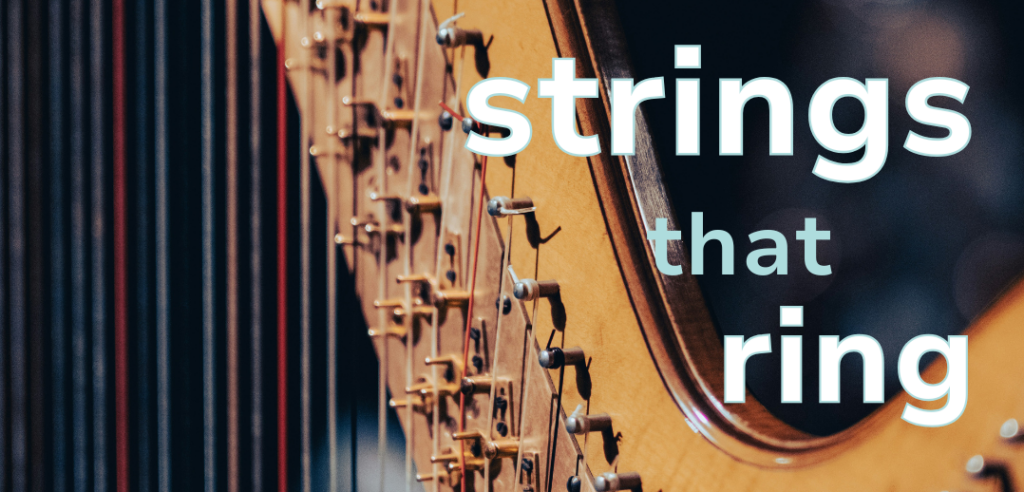Strings are one of the most important factors for a harp’s sound and reliability. After all, they are the actual contact point for our fingers: the place where the “rubber meets the road.” Having the right choice of strings on your harp and replacing them on a regular schedule can make a huge difference in tone and playing experience. But how do you know which strings are right for your harp? Today we will explore many string options, with a particular focus on the new pedal harp gut strings on the market.
If you use pedal gut strings, you may have noticed that in recent years the supply and quality has been inconsistent, especially in the fourth and fifth octaves. The exact causes of these issues are not clear, but likely related to agricultural issues, labor and supply chain problems, and unreliability of natural materials (cow gut in this case). I have experienced first-hand the panic of trying to order a replacement string, only to discover that multiple retailers are out of stock. This imbalance in supply and demand has led to a recent increase in new brands on the market. We will explore these new options and give you some helpful guidance in deciding which strings to try on your own harp. Sound and tone are of course always subjective, and each harpist has unique musical needs and tastes, so keep in mind that, in the end, all string and sound opinions are personal, and your mileage may vary.
String basics
This first step in determining what strings to buy is always to first know what the manufacturer of your harp recommends. Most harp manufacturers or retailer websites will have string charts available, or if you can’t find one, just email or call your harp maker. This is an especially important step for lever harpists, as the labeling of strings is not always consistent from brand to brand. It is also important to know if your lever harp needs “lever” or “pedal” strings. Some lever harps use the same strings as pedal harps (examples include the Lyon & Healy Troubadour and Prelude, and the Salvi Gaia), while others use different gauge lever strings.
Once you know the manufacturer’s recommended string brand, you still have some options to customize your sound and material preferences. Make sure to ask the manufacturer and/or your harp regulator before venturing away from the standard string choices for each octave. Sometimes choosing custom options is totally fine, but occasionally it can cause problems if the thickness or tension of the string is different from what your harp was built for. One common choice harpists consider is whether to use nylon or gut strings in the first and second octave. Factors in this decision include your personal sound preferences, budget, and intended use for the harp. If you have had nylon on your first octave and decide to switch to gut (or vice versa), make sure to time the switch right before a regulation. The thickness of the strings could be different, causing your half-step intonation to change.
This leads us to the next important consideration: how often do strings need to be changed? Of course the most obvious answer is when they break. But, if your time and budget allow, a partial or full string change can help your harp “sing” more beautifully and prevent string breakage at inconvenient times (like right before your big performance). Longtime harp technician Peter Wiley recommends a string changing schedule that keeps the ages of all strings no more than 10 years apart, preferably five to six years if possible.
Professional use:
- First/second octaves: Once yearly
- Third octave: Every other year
- Fourth/fifth octaves: Every four to five years
- Bass Wires: Once yearly
Average use:
- First/second octaves: Every two years
- Third octave: Every three years
- Fourth/Fifth octaves: Every five to six years
- Bass Wires: Every two to four years
Wiley explains, “The entirety of the strings make a chorus. I have often told harpists to pick a year—say 2025—and restring completely, then follow up with a full restring at the beginning of any year that ends in 5 (2035, 2045). That way your chorus does not have any singers from the Happy Retirement Glee Club. The result is amazing! Perks the harp up to a good degree having every string fresh.”
Whenever possible, it is best to time your string changes a few weeks before regulation. Fresh strings make the regulator’s job easier and prevent the chances of a false or worn-out string causing regulation issues.
Nylon options
Most of this article is focused on gut and gut alternative strings, but we did want to mention nylon string options. Nylon strings are commonly used by pedal harpists in the first, second, and sometimes third octaves. Most lever harps use some nylon strings, and some lever harps are entirely strung with nylon. Nylon strings are not made from a natural product, so their supply is reliable and plentiful, and their cost is much lower than gut strings. They also break much more rarely than gut strings and are less affected by changes in temperature or humidity.
The Sipario BioNylon is a new nylon option on the market. Sipario strings are manufactured by Lyon & Healy/Salvi and are a relatively new brand. According to Lyon & Healy: “Sipario Bionylon pedal harp strings are made with Bionylon monofilaments, an eco-friendly material composed of 63 percent vegetable derivative (castor oil), and with excellent mechanical and acoustic properties.” New harps sold by Lyon & Healy or Salvi are coming out of the factories with the BioNylon strings in their first octaves. I have them on one of my harps, and have found them to be very similar to other nylon strings in sound and durability. Their appearance is a little glossier and the texture slightly smoother under the fingers, but I had no problems adjusting. A first octave set (9 strings including 00G and 0F) is $31.50.
A familiar product for many harpists, the Vanderbilt Nylon strings manufactured by Vanderbilt Music have been an option for many years. A first octave set is $14.40.
Virginia Harp Center Nylon strings for pedal harp are the same gauge as the Vanderbilt or Lyon & Healy nylon strings. A first-octave set is $13.50.
Pirastro is a less commonly used brand, but does make a nylon string. Peter Wiley describes them as “very good, they are slightly thicker (gauged) than standard. Warmer in tone and longer lasting than standard.” A more expensive string, a first-octave set is $72.90.
For lever harp nylon strings (and again, check to see if your particular make and model of harp uses lever harp or pedal harp gauge strings), there are more options: Bow Brand Lever Nylon ($3.30), Camac Nylon ($6.00), and Dusty Strings Nylon ($3.25). Since the number of strings in the first octave varies on lever harps, the pricing given in parentheses is for one first octave string.
$tring$
Prices for harp strings can vary depending on manufacturers and materials. Here’s a look at cost per octave for the strings featured in this article. Numbers reflect published prices in September 2024.
Nylon
(price of one first-octave string, multiplied by 9 to account for the 00G and 0F strings)
- Sipario BioNylon: $31.50
- Vanderbilt: $14.40
- Pirastro: $72.90
Gut
(price of one fourth-octave string, multiplied by 7)
- Bow Brand Gut: $167.93
- Bow Brand Burgundy Gut: $103.95
- Vanderbilt Classic Gut: $154.70
- Premier: $140.00
- Sipario BioCarbon: $101.50
- Sipario GutGold: $161.00
In between your “chorus refresh” string changes, Wiley’s recommended new string schedules are:
Gut options
Bow Brand strings are likely familiar to many harpists, as they have long been a leading brand for pedal and lever gut strings. Manufactured in the UK, they are carried by most harp retail stores, and for many years were what came on Lyon & Healy and Salvi harps out of the factory. You may have noticed that in the last year they have changed their packaging. Ana Maddox of Bow Brand says, “The decision to change our packaging was driven by a strong commitment to environmental responsibility. I couldn’t, in good conscience, continue using plastic bags, knowing the significant carbon footprint associated with their production and transport added to the devastating impact of plastic pollution to our seas. Although our previous paper cards were recyclable, they had a semi-gloss finish, were bleached white, and required a considerable amount of printing ink—all processes that are harmful to the environment.
“The ‘new’ packaging is a significant step forward. It’s made from recycled paper, which is easily recyclable after use, and we’ve redesigned it to reduce the amount of ink used by a significant amount. However, we understand this change has caused some issues. While we searched for a more suitable alternative, we temporarily switched to a resealable sticker closure.
“We have now found a suitable replacement for plastic bags: a plant-based, biodegradable material called PLA. Moreover, it’s produced locally in the UK and is lightweight, helping reduce delivery costs.”
I also asked Maddox about any changes to Bow Brand’s production, given the supply and breakage issues of recent years.
“Yes, there have been changes,” she says. “After a particularly challenging year in 2022, which resulted in significant back orders and shortages, we realized the need to reassess and update our production processes. While we haven’t reinvented the wheel, we’ve made necessary updates to ensure better consistency and quality moving forward.”
Maddox also notes that Bow Brand is going back to longer lengths of second and third octave gut strings after having shortened the length in each package a few years ago.
Bow Brand also offers Burgundy Gut strings, which are discounted due to slight imperfections in appearance, but are otherwise equivalent to the standard Bow Brand Gut.
A fourth-octave set of Bow Brand Gut is $167.93. Burgundy is $103.95.
Vanderbilt Classic Gut strings have come back on the market in recent years. According to their website, Vanderbilt Classic Gut strings have the same characteristics and production as before.
Vanderbilt Classic Gut strings are the same gauge as Bow Brand, so a regulating immediately after changing brands isn’t necessary. They also sell first, second, and third octaves in packages where the length is enough to string at least two times. The packaging is a plastic resealable bag.
I have used Vanderbilt Classic Gut on my personal harps, as well as the harps at the University of Houston, and have found them to be very consistent and durable and sound great. I have not noticed any problems when interchanging them with Bow Brand (for example, replacing just one string or one octave with Vanderbilt Classic Gut).
Harp technician Steve Moss commented, “I have used Vanderbilt extensively and find them to be of excellent quality.”
A fourth-octave set of Vanderbilt Classic Gut is $154.70.
Premier Gut strings are made in France, and are commonly used on Camac harps, but can be used for any pedal or lever harp. Kayla Hanvey, the assistant manager of the Virginia Harp Center in Richmond, which sells Premier strings, describes their sound quality as “warm, buttery, and even. We find that they are also supple and easy to work with when tying string knots.”
Premier are slightly thinner than Bow Brand and Vanderbilt Classic Gut, but the difference is marginal. You would want a regulation directly after changing out your whole harp, or whole octaves, but probably don’t need to worry about regulation for changing a few strings here or there.
Premier strings are sold in plastic resealable packaging, and the first, second, and third octaves are sold in double lengths.
Houston harpist Kelsey Sham describes her first-hand experience with Premier: “I have been using Premier for years, and have never had any problems. I honestly love them and find them to be very durable and long lasting”.
A fourth-octave set of Premier Gut strings is $140.00.
A few years ago, Lyon & Healy and Salvi came out with a new line of gut-alternative strings. Sipario BioCarbon strings are made from a bio-plastic blend derived from sugarcane. Because gut strings are so sensitive to temperature and humidity changes, and their supply and quality depends on the (unfortunately variable) supply of quality natural materials, gut strings tend to be less reliable. Because they are not gut, the Sipario BioCarbon strings are less likely to go out of tune with temperature fluctuations, and break less. The white strings have a much brighter color to them than natural gut, and are much more visible in poor lighting.
String manufacturers have experimented with synthetic materials before, aiming for the warm, pure tone quality of gut, which is hard to match with any other material. These new Sipario BioCarbon strings are the latest attempt, and while relatively new, some harpists have tried them and can offer reviews. It is worth noting that these strings are a different gauge than natural gut strings, so you would need to plan on a regulation right after changing, and mixing and matching them with natural gut strings on your harp could cause inconsistency in intonation and tone. They also take much longer to come up to pitch than gut strings or even nylon strings. Salvi/Lyon & Healy recommend a slightly different stringing process than normal strings, where you manually push on the string, and then tune up to pitch over several days, repeating several times. They warn that tuning all the way up to pitch immediately could cause breakage. After a few days, you may need to unwind the string, pull tighter, and then rewind it in order to compensate for the string stretching that has occurred. Basically, this material is just very elastic, so will stretch a lot more and for a lot longer than gut. Harp technician Steve Moss, in an excellent and informative post on his blog, commented that even using the new techniques, the strings took longer than a week to become stable and hold pitch. Moss notes, “BioCarbon strings are the closest string yet developed to gut strings in sound, feel, and projection. A group of harpists and harp technicians was pleasantly surprised by how closely they approximate gut. This is not to say they sound the same,” he says. “I would describe the sound in general as a bit sharper and brighter than gut.”
Since BioCarbon strings are the newest option on the market, we asked a few harpists who have tried them to give us their thoughts. Bryan Lee, a harpist in Malaysia, says, “I changed the octaves two and three first, and I thought the sound was pretty okay so then I changed all the octaves. They’re way better with the humidity here, [and I] haven’t broken anything. I find that gut sound is still warmer and fuller, but biocarbons are more penetrating and articulate. I am not sure if it’s an older harp issue, I use a [Lyon & Healy] 23 that’s about 20 years old, but the fifth-octave strings were slightly too thick to fit into my pins. No matter what the technician tried, I still have slight buzzing on some strings in sharp when I play really loud. The technician said older discs are smaller and built nearer to each other so there’s a limit to how much can be adjusted. It’s not a big deal, it’s only extreme loud playing that triggers it, I would rather deal with that than strings breaking non-stop.”
Christian Chalifour, a harpist in Palm Springs, Calif., also experimented with Siparios. “My 10-year old Camac Athena EX harp was long overdue for new strings, and I had been reading up on the new Sipario BioCarbon strings,” he says. “I called several fellow harpists across the country, but I couldn’t find anyone who had actually tried them. So on a gamble, I decided to try them, and I really love them! They’re highly visible, and they’re the most stable strings I’ve ever seen. Once they settle in, they’re almost entirely unaffected by changes in temperature and humidity. Also, the red Cs and black Fs won’t ever fade at all like most other gut and nylon strings. I imagine it will be a different experience for every harpist who tries them. But, as I play 90 percent pop harp and am amplified most of the time, these strings are great.”
A fourth-octave set of Sipario BioCarbon is $101.50.
This year, Sipario released a new natural gut string called Sipario GutGold. These are traditional natural gut strings. These strings are the same gauge as Bow Brand and Vanderbilt Classic, and can be strung and pulled up to pitch just like any other gut string. New Lyon & Healy and Salvi harps are now being strung with Sipario GutGold in the factories.
Because these are a brand new product, very few harpists have test driven the new strings, but if you know someone who has purchased a harp manufactured in June 2024 or later and has the new GutGold strings, that would be a great opportunity to try them.
Moss says of his limited experience with the new strings, “I have been pleased with GutGold strings. The gauges seem consistent with those of Bow Brand, as does the sound. I have not experienced problems mixing the two brands on the same harp when necessary.”
A fourth octave set of Sipario GutGold is $161.00.
For lever harpists seeking a gut alternative, Sipario also offers the Silkgut string. This product has been available for more years, and some lever harps have come out of the factory strung with it. According to the Lyon & Healy website, Silkgut is a synthetic lever string that aims to imitate the acoustic characteristics of gut while offering more immunity to climate changes.
While the last few years have been challenging when it comes to strings, it is exciting to be in a new era with more options than ever for quality strings. As more harpists try different types of strings in search of the best fit for their instrument and individual sound, we all benefit from the greater variety of options, quality, pricing, and technological improvements. Happy harping, and hopefully not too much string changing! •
















